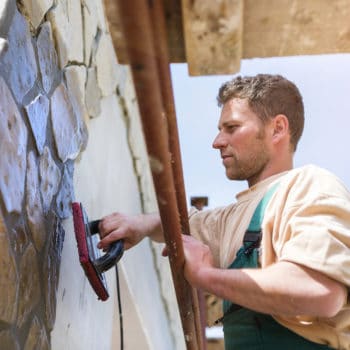Why We Love It
-
$33,980Potential Avg. Salary
-
1.2%Job Growth Rate
-
Growing DemandJob Outlook
-
Creativity FocusedCareer Attribute
Cabinetmakers are woodworkers who specialize in designing, building, and installing cabinets. Often, the role of the cabinet maker is to design and create specialized cabinets according to client specifications or to fit oddly shaped spaces. They use a variety of woods and tools to conduct their work.
Recommended Schools
What is a Cabinetmaker?
The following job responsibilities are common for individuals in cabinetmaker roles:
- Evaluate client requests and measure spaces in order to form designs that meet specifications and fit in available spaces
- Use a variety of wood and other materials, techniques, and tools to create cabinetry
- Paint, stain, or lacquer finished cabinets and install necessary hardware for use
- Install cabinets in client homes and offices
A Day in the Life
Cabinetmakers are woodworkers who specialize in creating cabinetry. Often, they’re called in when a client wants custom cabinets created and installed, or when cabinets are needed in spaces that do not fit common cabinet measurements. Cabinetmakers use a variety of materials and tools to perform their work. They’re experienced with identifying different types of wood, choosing the proper wood for the job and to meet client preferences, and cutting that wood to specifications using saws, sanders, chisels, and other tools.
The process of making cabinets generally starts by evaluating the space where the cabinets will be installed, and engaging in discussion with the client and other contractors. Often, cabinets will need to be customized to fit client preferences or will need special features to accommodate plumbing work. After a thorough investigation, the cabinet maker will get to work designing cabinets for the client. Usually, the client signs off and approves the design before the cabinetmaker starts building work.
Next, the cabinetmaker gets to work building cabinets. He measures and cuts the wood, puts cabinet pieces together, and paints, stains, or lacquers the finished product. Additionally, he installs hardware to make the cabinets usable, such as hinges and handles. Finally, the cabinetmaker may go on to install the cabinets for clients, or he/she may deliver the cabinets to the client’s location for installation by another contractor.
Typical Work Schedule
Many cabinetmakers are self-employed, so they’re able to work as many or few hours as desired. Additionally, they may be able to conduct their work during any shift desired, though working with clients and other contractors may require schedule accommodations. Cabinetmakers who work for manufacturing companies typically work full-time during normal business hours.
Typical Employers
Some cabinetmakers are self-employed and take on clients on a freelance basis. Others work for manufacturing companies that produce and distribute cabinets to wholesalers or other sales and distribution companies.
Recommended Schools
How To Become a Cabinetmaker
No formal postsecondary education is required to work as a cabinetmaker, and many learn the skills needed on the job in training programs under experienced cabinet makers. While training, aspiring cabinet makers learn how to identify different types of wood, learn how different types of wood should be used, and learn how to operate machinery used in the role. In some cases, machinery may be manually operated, and in other cases, cabinetmakers learn how to operate computer-guided tools.
Finding a self-employed cabinetmaker who’s willing to take on and train an apprentice may be difficult, so cabinetmakers who opt to avoid postsecondary education opportunities usually end up starting in entry-level positions for manufacturing companies. For those who want to begin their careers as self-employed cabinetmakers, getting formal training in a college training program can be beneficial because the skills you learn will allow you to start taking on clients right after graduation.
Woodworking and cabinetry certificate and degree programs are commonly offered in community, technical, and vocational colleges and schools. Students in these programs study wood technology, furniture manufacturing, and engineering topics that equip them to excel as cabinetmakers. Additionally, some students find it beneficial to take courses in business administration in order to learn the skills needed to operate their own cabinet-making business and find clients.
Cabinetmaker Salary Data
We’ve provided you the following to learn more about this career. The salary and growth data on this page comes from recently published Bureau of Labor Statistics data while the recommendations and editorial content are based on our research.
National Anual Salary
Low Range
$25,380Average
$33,980High Range
$49,940National Hourly Wage
Low Range
$12/hrAverage
$16/hrHigh Range
$24/hrHow do Cabinetmaker salaries stack up to other jobs across the country? Based on the latest jobs data nationwide, Cabinetmaker's can make an average annual salary of $33,980, or $16 per hour. This makes it an Above Average Salary. On the lower end, they can make $25,380 or $12 per hour, perhaps when just starting out or based on the state you live in.
Salary Rankings And Facts
#639 Nationally for All Careers
Highest Education Among Cabinetmakers
- 0.2% Doctorate
- 0.8% Masters
- 5.9% Bachelors
- 6% Associates
- 19.7% College
- 49.1% High School
- 18.3% Less than High School
Job Growth Projections and Forecast
2014 Total Jobs
98,1002024 Est. Jobs
99,300Job Growth Rate
1.2%Est. New Jobs
1,200How does Cabinetmaker job growth stack up to other jobs across the country? By 2024, there will be a change of 1,200 jobs for a total of 99,300 people employed in the career nationwide. This is a 1.2% change in growth over the next ten years, giving the career a growth rate nationwide of Below Average.
Growth Rankings And Facts
#572 Nationally for All Careers
What Companies Employ The Most Cabinetmakers
| Industry | Current Jobs | New Jobs Needed | % Increase |
|---|---|---|---|
| Wood kitchen cabinet and countertop manufacturing | 37,500 | 3,100 | 3% |
| Office furniture (including fixtures) manufacturing | 13,900 | -600 | -1% |
| Household and institutional furniture manufacturing | 11,200 | -1,300 | -1% |













